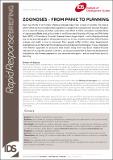Zoonoses: From panic to planning

Download
Date
2013-12-12Author
Holley, Catherine
Jones, Kate
Leach, Melissa
Marks, Naomi
Scoones, Ian
Welburn, Sue
Wood, James
Grace, Delia
Metadata
Show full item recordImpact
Abstract
Over two thirds of all human infectious diseases have their origins in animals. The rate at which these zoonotic diseases have appeared in people has increased over the past 40 years, with at least 43 newly identified outbreaks since 2004. In 2012, outbreaks included Ebola in Uganda (see Ebola box), yellow fever in the Democratic Republic of Congo and Rift Valley fever (RVF) in Mauritania. Zoonotic diseases have a huge impact – and a disproportionate one on the poorest people in the poorest countries. In low-income countries, 20% of human sickness and death is due to zoonoses. Poor people suffer further when development implications are not factored into disease planning and response strategies. A new, integrated ‘One Health’ approach to zoonoses that moves away from top-down disease-focused intervention is urgently needed. With this, we can put people first by factoring development implications into disease preparation and response strategies – and so move from panic to planning.
Citation
Grace, D., Holley, C., Jones, K., Leach, M., Marks, N., Scoones, I., Welburn, S., Wood, J. (2013) Zoonoses - from panic to planning. IDS Rapid Response Briefing 2.Is part of series
IDS Rapid Response Briefing;2Rights holder
Instiute of Development StudiesSponsor
Ecosystem Services for Poverty Alleviation (ESPA), DFIDCollections
- IDS Research [1671]
- Dynamic Drivers of Disease in Africa [14]
